German and US Partners Join Forces in Stem Cell Research to Accelerate Development of New Therapies
Researchers at The Scripps Research Institute (TSRI) in California, USA, and two German institutes, the Center for Integrated Psychiatry Kiel (ZIP) and the Fraunhofer Institute for Molecular Biology and Applied Ecology IME, have announced a partnership to advance the quality control of human stem cells.
Scientists now routinely create “induced pluripotent stem cells,” called iPSCs, which have enormous potential for regenerative medicine, research, and development of new therapeutic agents. To assure that high-quality iPSCs are available for research and clinical use, the collaborators are developing rigorous new genomics-based methods to analyze the cells.
iPSCs are made by taking a mature cell, such as a skin cell, and dialing back its developmental programming so it becomes a stem cell, capable of differentiating into virtually any cell type in the body.
“Quality control is our major goal,” said Professor Jeanne Loring of TSRI. “We must ensure that the neurons and other cells derived from iPSCs for clinical use and drug discovery are the ideal cell type for the application. As an analogy, imagine the development of a classical drug treatment. The pills that are provided to patients must contain the right amount of the right drug. Our work applies the same quality control principles to stem cells.”
Taking Quality Control to the Next Level
The project is jointly funded by the California Institute for Regenerative Medicine (CIRM) and the German Ministry of Education and Research (BMBF). Loring will receive $1.8 million for the project in California, and the BMBF will provide matching funds for the German part of the project, for which Franz-Josef Müller (Cluster of Excellence “Inflammation at Interfaces”) is coordinator. The grant will help the team advance a biotechnological tool called “PluriTest,” developed and introduced in 2011 by Loring and Müller, previously at TSRI and now studying neuropsychiatric disorders and inflammation at the ZIP in Germany. The new software will be called "PluriTest2."
“We will take the next technological step, next generation sequencing, in order to close gaps in stem cell quality control,” said Müller. “In contrast to previous microarray-based technology, we can now see every gene that is expressed in the cell in much more detail. This allows us to draw even more extensive and reliable conclusions on pluripotency, validity of our in vitro models and patient safety.“
Loring noted the international collaboration is very promising. “The dynamics of international experts working together in a collaborative spirit is inspiring,” she said. “In this case, since our German partners at the Fraunhofer IME are leading experts in the area of early-stage drug discovery, I am especially hopeful that the work will lead to significant scientific insights and progress in new approaches to drug development.”
While patient safety and acceleration of new therapies are strong arguments for optimizing biotechnological tools, researcher Ole Pless, of the IME-ScreeningPort also noted the project offers the pharmaceutical sector huge potential savings. “Until now, a lot of money has been burned by high failure rates in drug development,” Pless said. “So we urgently need to improve pre-clinical disease and toxicity models to lower those rates. We need to see earlier on in the process whether we are heading in the right direction with a possible therapeutic agent or not. And we expect that with iPS cells we could considerably enhance the chance of success.”
Send comments to: press[at]scripps.edu














